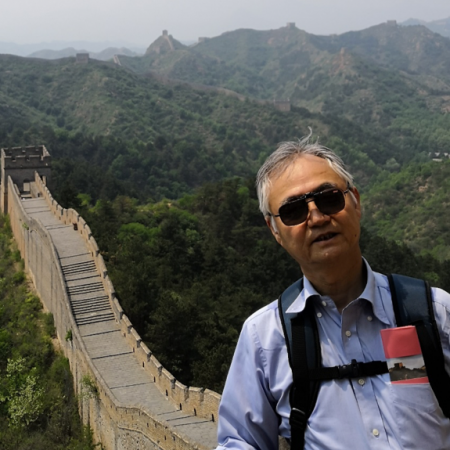
Arata Nishimura at JinShanLing Great Wall.
Arata Nishimura
National Institute of Science, Japan; Technical Institute of Physics and Chemistry, Chinese Academy of Sciences
Friday, July 19, 2019
10:30am
Abstract: D-T fusion reaction will generate a lot of high energy neutrons. If we could take out the (kinetic) energy of the neutrons, the converted (thermal) energy will be usable as a fusion energy.
Since the fusion reactor will emit a lot of high energy neutrons, all devices and components in the building will be irradiated and activated, also the building itself. In addition, the secondary activation must be considered. Most of the large-scale plasma devices have been operated only for non D-T plasma so the radiation measures have not been necessary. When the device is designed with an idea of the D-T reaction, the construction site has to be satisfied several conditions and special facilities must be equipped. In this talk, such consideration on the construction site conditions will be introduced first. The nitrogen isotopes of 16N and 17N will be introduced as a practical example of the secondary activation.
Following the first topics, the importance of total design scenario will be discussed. The integration and assembly processes must be considered in parallel with the component design. Especially, the prospect of key component assembly like TF coils or vacuum vessels is very important. A new assembly concept of the large-scale TF coils will be presented and discussed.
It is known that SPARC project requires over 20 T and the high temperature superconducting (HTS) tape is the only solution to be adopted in a sense of engineering. Since the Ic of HTS tape has an inclined angle dependence to the magnetic field, the lowest Ic must be confirmed as a design value when the AC losses are considered. And it is not easy to bend and twist the tape. When the twisted tape is bent, it deforms into a polygon shape. Although the speaker’s understanding of the SPARC project is limited, the challenging image of the magnet structure will be proposed, and the weakest point of this magnet design will be discussed. On design of large-scale component, it is a key to know what is and where is the weakest point of the product.
Bio: Arata Nishimura finished a Doctoral course in Welding Engineering, Osaka University, in 1982. The title of his Doctoral thesis was “Fatigue crack propagation behavior in hardness heterogeneous field due to welding.” Then, he became a research associate in Department of Welding Engineering, Osaka University. He developed a special transition joint for 304 and A5083, dissimilar materials joint, which is now a popular joint for cryogenic piping.
On January 1991, he moved to National Institute for Fusion Science as an associate professor and became a professor in 2000. He joined the Large Helical Device project and, mainly, worked for Superconducting magnet design, related R&Ds and LHD constructions. He also designed and built the mechanical cooling water systems, and took part in the design of the LHD main experimental building.
The first plasma operation was successfully done in March 1998, and he changed positions from LHD Project to Research Center for Fusion Reactor Engineering. To investigate the neutron irradiation effect on the Ic of SC wires, 15.5T magnet and a variable temperature insert were installed in the radiation control area. Also, the R&Ds on the new cryogenic structural material (>1200 MPa yield stress and >150 MPa√m fracture toughness at 4.2K) has been performed. These two activities are continuing still now.
From 2012 to 2015, he was a deputy magnet division head of ITER International Organization. The integration and assembly scenarios of SC coils and vacuum vessels have not been completed. So, at present, the components and so on are under manufacturing without the integration design. After coming back to Japan from France, MEXT requested him to join fusion DEMO design activity, which is a part of Broader Approach program between JA and EU, as a general coordinator of Fusion DEMO Design Team. In parallel with the coordinator activity, he investigated the construction site conditions for the Fusion DEMO.
On March 31, 2019, he retired from NIFS and was awarded the title of Professor Emeritus from NIFS and from The Graduate University for Advanced Studies (SOKENDAI). He is now staying at Technical Institute of Physics and Chemistry, Chinese Academy of Sciences, in Beijing, China, as an international visiting professor.